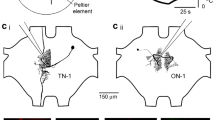Summary
-
1.
The anatomical and physiological characteristics of filiform hairs, receptor elements on the cerci of the cricketAcheta domesticus, were investigated, with special attention to possible physiological differences between anatomically defined subclasses.
-
2.
Maps of the distribution of hair socket orientations on the cercus show that the filiform hairs can be divided into two main subclasses: those whose sockets are oriented longitudinally and whose hair shafts vibrate transversely (T-hairs), and the reciprocal subclass whose sockets are oriented transversely and whose shafts vibrate longitudinally (L-hairs), with respect to the long axis of the cercus. T-hairs are found on the dorsal and ventral surfaces of the cercus, while the L-hairs are on the medial and lateral surfaces. Obliquely oriented hairs lie primarily at the margins of the well defined T-and L-populations. Hair density is greatest at the base of the cercus.
-
3.
Intracellular cobalt fills of physiologically characterized receptor axons reveal that the processes branch profusely before terminating in the ipsilateral neuropile of the terminal abdominal ganglion.
-
4.
Intracellular recordings from the axons of filiform hairs show that the receptors respond tonically to tones. The receptors studied responded with a phase-locked spike train to tones up to a frequency of about 200 Hz. They showed a preference for sound sources situated either transversely or longitudinally to the longitudinal axis of the cercus. Other than directional preference, no physiological differences were detected between the response properties of T-and L-cells.
Similar content being viewed by others
References
Bentley, D.: Single gene cricket mutations: Effects on behavior, sensilla, sensory neurons and identified interneurons. Science187, 760–764 (1975)
Edwards, J.S., Palka, J.: Neural regeneration: Delayed formation of central contacts by insect sensory cells. Science172, 591–594 (1971)
Edwards, J.S., Palka, J.: The cerci and abdominal giant fibres of the house cricket,Acheta domesticus. I. Anatomy and physiology of normal adults. Proc. Roy. Soc. Lond. B185, 83–103 (1974)
Fielden, A.: Transmission through the last abdominal ganglion of the dragonfly nymph,Anax imperator. J. exp. Biol.37, 832–844 (1960)
Gnatzy, W.: The ultrastructure of the thread hairs on the cerci of the cockroachPeriplaneta americana L.: The intermoult phase. J. Ultrastruct. Res.54, 124–134 (1976)
Gnatzy, W., Schmidt, K.: Die Feinstruktur der Sinneshaare auf den Cerci vonGryllus bimaculatus Deg. (Saltatoria, Gryllidae). I. Die Faden-und Keulenhaare. Z. Zellforsch, mikr. Anat.122, 190–209 (1971)
Matsumoto, S.G., Murphey, R.K.: The cercus-to-giant interneuron system of crickets. IV. Patterns of connectivity between receptors and the Medial Giant Interneuron. J. comp. Physiol.119, 319–330 (1977)
Matsumoto, S.G., Murphey, R.K.: Sensory deprivation during development decreases the responsiveness of cricket giant interneurons. J. Physiol. (London) in press (1977)
Mendenhall, B., Murphey, R.K.: The morphology of cricket giant interneurons. J. Neurobiol.5, 565–580 (1974)
Michelsen, A., Nocke, H.: Biophysical aspects of sound communication in insects. Adv. Insect Physiol.9, 247–296 (1974)
Murphey, R.K., Matsumoto, S.G.: Experience modifies the plastic properties of identified interneurons. Science191, 564–566 (1976)
Murphey, R.K., Matsumoto, S.G., Mendenhall, B.: Recovery from deafferentation by cricket interneurons after reinnervation by their peripheral field. J. comp. Neurol.169, 335–346 (1976)
Murphey, R.K., Mendenhall, B., Palka, J., Edwards, J.S.: Deafferentation slows the growth of specific dendrites of identified giant interneurons. J. comp. Neurol.159, 407–418 (1975)
Murphey, R.K., Palka, J., Hustert, R.: The cercus-to-giant interneuron system of crickets. II. Response characteristics of two giant interneurons. J. comp. Physiol.119, 285–300 (1977)
Nicklaus, R.: Die Erregung einzelner Fadenhaare vonPeriplaneta americana in Abhängigkeit von der Größe und Richtung der Auslenkung. Z. vergl. Physiol.50, 331–362 (1965)
Palka, J., Edwards, J.S.: The cerci and abdominal giant fibres of the house cricket,Acheta domesticus. II. Regeneration and effects of chronic deprivation. Proc. Roy. Soc. Lond. B185, 105–121 (1974)
Palka, J., Olberg, R.: The cercus-to-giant interneuron system of crickets. III. Receptive field organization. J. comp. Physiol.119, 301–317 (1977)
Palka, J., Schubiger, M.: Central connections of receptors on rotated and exchanged cerci of crickets. Proc. Nat. Acad. Sci. USA72, 966–969 (1975)
Petrovskaya, E.D., Rozhkova, G.I., Tokareva, V.S.: Characteristics of single receptors of the cereal auditory system of the house cricket. Biofizika15, 1112–1119 (1970)
Pumphrey, R.J., Rawdon-Smith, A.F.: Hearing in insects: The nature of the response of certain receptors to auditory stimuli. Proc. Roy. Soc. Lond. B121, 18–27 (1936)
Usherwood, P.N.R., Grundfest, H.: Peripheral inhibition in skeletal muscle of insects. J. Neurophysiol.28, 497–518 (1965)
Wiese, K., Calabrese, R.L., Kennedy, D.: Integration of directional mechanosensory input by crayfish interneurons. J. Neurophysiol.39, 834–843 (1976)
Author information
Authors and Affiliations
Additional information
This work was supported by grants from the U. S. Public Health Service (NS-07778) and the John Simon Guggenheim Memorial Foundation (J. P. and M. S.), and the National Science Foundation (BN 54523454) to R.K. Murphey (R.L.). We are grateful to Malcolm Burrows for the hospitality of his laboratory, and to him, Rod Murphey, John Edwards and David Bentley for critical reading of the manuscript.
Rights and permissions
About this article
Cite this article
Palka, J., Levine, R. & Schubiger, M. The cercus-to-giant interneuron system of crickets. J. Comp. Physiol. 119, 267–283 (1977). https://doi.org/10.1007/BF00656638
Received:
Issue Date:
DOI: https://doi.org/10.1007/BF00656638




